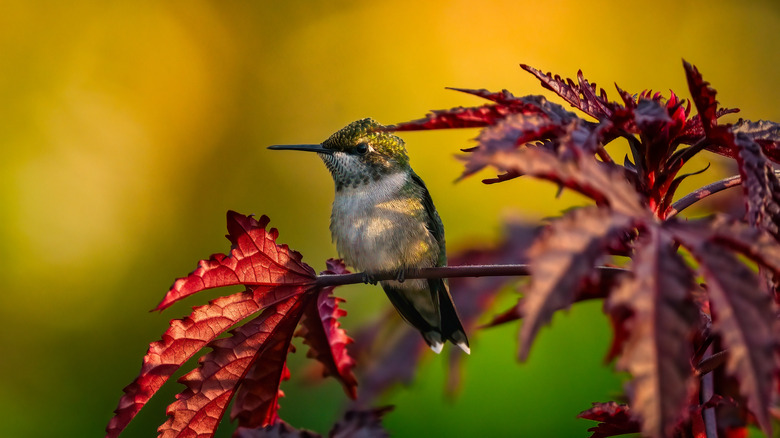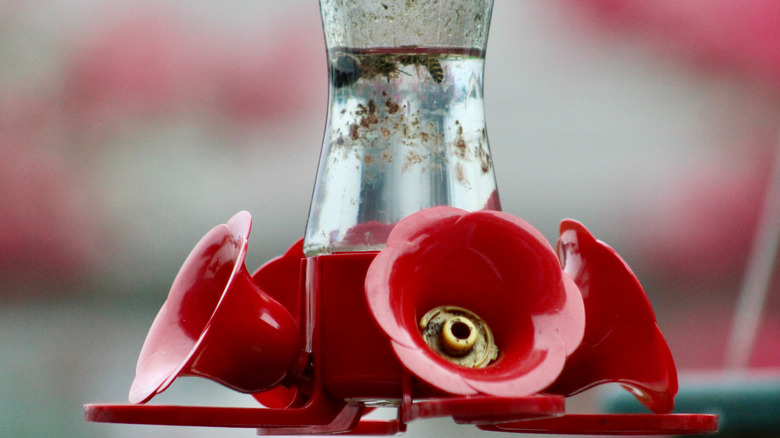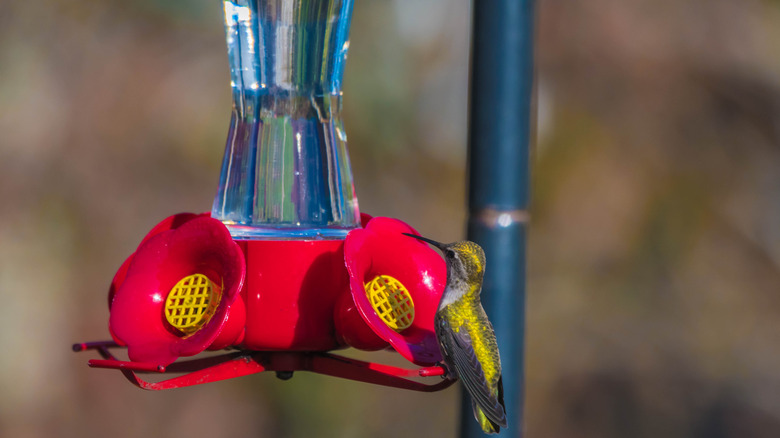What To Avoid To Ensure Hummingbirds Will Visit Throughout The Fall
We all know pollinators are vital for our gardens and for the planet. When you tend to your yard, you're playing a direct hand in the well-being of these important organisms. It's easy to make accommodations when those pollinators are as mesmerizing as hummingbirds. These feathered friends play a huge role in pollination and make your backyard sanctuary that much more tranquil. There are plenty of ways to draw hummingbirds into your yard. But if you want to welcome these tiny birds into your yard this fall, you should consider what to avoid too. It's vital to diligently maintain your hummingbird feeder. If you don't clean it out regularly, it could grow black mold and harm your feathered visitors.
During the fall, many hummingbird species across North America embark on their mass migration south for the winter. As their breeding season comes to a close, species such as the ruby-throated hummingbird and the black-chinned hummingbird return to warmer regions. Their long trek begins in August and comes to a close around October. During that time, bird lovers have the chance to catch a glimpse of hummingbirds that don't typically spend much time in their neck of the woods. If you want to aid in their long journey south, be sure to keep their feeders cleaned and stocked with fresh nectar.
A clean and mold-free feeder is essential
Hummingbirds are constantly on the move, wings fluttering from 720 to 5400 times per minute at a hover. All that spent energy requires frequent feeding. Hummingbird have a varied diet including insects and flower nectar, but feeders offer supplemental food they desperately need on their long journey south. That being said, you can't set the feeder out without committing to regular maintenance. If you let it sit out too long, it may become a petri dish of harmful mold and bacteria. Black mold is particularly harmful to hummingbirds, causing a disease called candidiasis. Candidiasis can cause a hummingbird's tongue swell, making it impossible for them to feed. Black mold spores may also get lodged in their lungs causing a lethal respiratory disease called aspergillosis.
To keep your feathered visitors healthy, clean out, disinfect, and replenish with fresh nectar every 3 to 4 days in mild temperatures, or up to once daily when the weather is hot. Start by emptying out your feeder and cleaning it with hot water. You should avoid using dish soaps, but diluted white vinegar or hydrogen peroxide is safe for washing. Use a small brush to scrub hard to reach areas. To sterilize, soak the feeder in 1 part bleach to 9 parts water or in a solution of 1 part vinegar to 2 parts water for about an hour (never mix bleach and vinegar). Alternatively, you can run it through the dishwasher before refilling with fresh nectar. Hang the feeder somewhere shady to avoid speeding up the mold growth process. If you see any signs of mold such as black spots, take down and clean your feeder immediately.
Choose feeders and food recipes that allow for good health
The type of nectar you provide matters too. There are a variety of store bought nectars on the market but they aren't as favorable as homemade nectar, and may contain too much sugar or other additives. Luckily, making your own solution is super easy. Simply bring 4 cups of water to a boil, then add 1 cup of sugar and dissolve. Adding too much sugar can increase the chance of mold growth. Allow the solution to cool completely before filling up your hummingbird feeder, and store any leftover nectar in the fridge, warming it to room temperature again before offering it to your birds.
Don't be tempted to add anything extra into your solution. Other sweeteners like honey, brown sugar, or raw, unprocessed sugar aren't suitable for hummingbirds — stick with a 4:1 ratio of water to refined white sugar. You may have also heard that red food coloring can attract more visitors to your feeder, but this is unnecessary. Aside from being potentially harmful to the birds, red dye can also make it harder to notice any mold growing inside the vessel. The best hummingbird feeders are those that can be cleaned and monitored easily. Opting for unique hummingbird feeders can add whimsy to any yard, but the birds' health and safety should come first, and healthy, happy birds will be more likely to return to your feeder next year.


